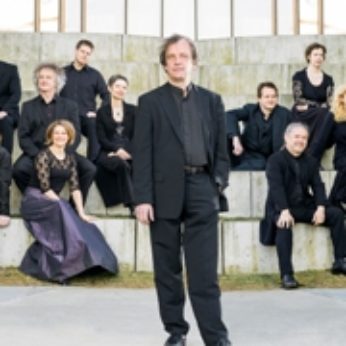Composer: Heinrich Ignaz Franz Biber (b. 1644 - d. 1704)
Performance date: 01/07/2014
Venue: St. Brendan’s Church
Composition Year: 1673
Duration: 00:06:17
Recording Engineer: Richard McCullough, RTE
Instrumentation Category:Small Mixed Ensemble
Instrumentation Other: tpt, 3vn, va, vc, db, lu, hpd
Artists:
Sebastian Philpott -
[trumpet]
Concerto Copenhagen (Peter Spissky, Fredrik From, Antina Hugosson [violins], Torbjörn Köhl [viola], Kate Hearne [cello], Mattias Frostenson [bass], Fredrik Bock [archlute, guitar], Lars-Ulrik Mortensen [harpsichord, director]) -
[baroque ensemble]

Heinrich Ignaz Franz Biber was born in 1644
in the small Bohemian town of
died in 1704 in
Although many of Biber’s masterworks have only come to light in recent years,
he has been proclaimed by some as the greatest composer before JS Bach, his
works being praised for their sonority, timing, profundity and wit.
His sonata à 6 is dated from 1673, three
years after he joined the court in
where he was to spend the last 35 years of his life, eventually being knighted
von Bibern by Emperor Leopold I in 1690. The manuscript of this sonata,
however, was discovered in his earlier place of employment at the
deep in the
renowned for its trumpet corps, and especially the chief court trumpeter Pavel
Josef Vejvanovsky [1640-1693] who is known to be one of the most versatile
trumpeters in the history of his instrument. Biber continued to write for this
eminent musician many years after his departure from Krom??íž.
The sonata à 6 opens with a fanfare motive
in C major, imitating various battle pieces from the Renaissance and early
Baroque periods. As the sonata unfolds, Biber develops techniques more in
accord with his earlier violin sonatas, alternating sections for solo violin
with imitative and fugal passages for the full ensemble. The sonata is
basically through composed, each section flowing seamlessly into the next by
overlapping the cadential melodies with the beginning of the following section.
Biber bases much of the sonata around a descending triad, cleverly disguising
it through different means, but the trumpet gets the last word, imitating a
triad voiced by the strings to end the work.
Copyright © 2025 West Cork Music. All rights reserved.
Designed and developed by Matrix Internet